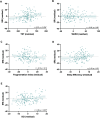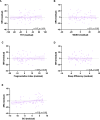Sleep regularity index as a novel indicator of sleep disturbance in stroke survivors: a secondary data analysis
- PMID: 40394026
- PMCID: PMC12092764
- DOI: 10.1038/s41598-025-01332-4
Sleep regularity index as a novel indicator of sleep disturbance in stroke survivors: a secondary data analysis
Abstract
Sleep disturbance is common but often overlooked after stroke. Regular sleep is increasingly recognised as important for overall health, yet little is known about how sleep regularity changes after stroke. This study examined differences in the Sleep Regularity Index (SRI) between stroke survivors and healthy controls using actigraphy data from an existing dataset (~ 1 week per participant). Data were analysed for 162 stroke survivors (mean age 61 ± 14 years, 5 ± 5 years post-stroke, 89 males) and 60 controls (mean age 57 ± 17 years, 32 males). Stroke survivors had significantly lower SRI scores than controls (p = 0.001), indicating less regular sleep. In the stroke group, higher SRI correlated with longer total sleep time (p = 0.003) and better self-reported sleep quality (p = 0.001) but not with other sleep metrics. Lower SRI was associated with worse depressive symptoms (p = 0.006) and lower quality of life (p = 0.001) but not with disability (p = 0.886) or time since stroke (p = 0.646). These findings suggest that sleep regularity is disrupted post-stroke and may influence well-being. Future research should explore interventions to improve sleep regularity and related health outcomes in stroke survivors.
Keywords: Actigraphy; Circadian rhythm; Post-stroke recovery; Quality of life; Sleep-wake patterns.
© 2025. The Author(s).
Conflict of interest statement
Declarations. Competing interests: The authors declare no competing interests.
Figures






Similar articles
-
Self-Reported and Objective Sleep Measures in Stroke Survivors With Incomplete Motor Recovery at the Chronic Stage.Neurorehabil Neural Repair. 2021 Oct;35(10):851-860. doi: 10.1177/15459683211029889. Epub 2021 Jul 1. Neurorehabil Neural Repair. 2021. PMID: 34196598 Free PMC article.
-
Irregular sleep-wake patterns in older adults with current or remitted depression.J Affect Disord. 2021 Feb 15;281:431-437. doi: 10.1016/j.jad.2020.12.034. Epub 2020 Dec 11. J Affect Disord. 2021. PMID: 33360364
-
Sleep Regularity Index in Patients with Alcohol Dependence: Daytime Napping and Mood Disorders as Correlates of Interest.Int J Environ Res Public Health. 2020 Jan 3;17(1):331. doi: 10.3390/ijerph17010331. Int J Environ Res Public Health. 2020. PMID: 31947749 Free PMC article.
-
Effect of exercise based interventions on sleep and circadian rhythm in cancer survivors-a systematic review and meta-analysis.PeerJ. 2024 Mar 8;12:e17053. doi: 10.7717/peerj.17053. eCollection 2024. PeerJ. 2024. PMID: 38468641 Free PMC article.
-
Investigating efficacy of two brief mind-body intervention programs for managing sleep disturbance in cancer survivors: a pilot randomized controlled trial.J Cancer Surviv. 2013 Jun;7(2):165-82. doi: 10.1007/s11764-012-0252-8. Epub 2013 Jan 22. J Cancer Surviv. 2013. PMID: 23338490 Free PMC article. Review.
References
-
- Kim, A. S., Cahill, E. & Cheng, N. T. Global stroke belt: Geographic variation in stroke burden worldwide. Stroke46, 3564–3570 (2015). - PubMed
MeSH terms
Grants and funding
LinkOut - more resources
Full Text Sources
Medical

